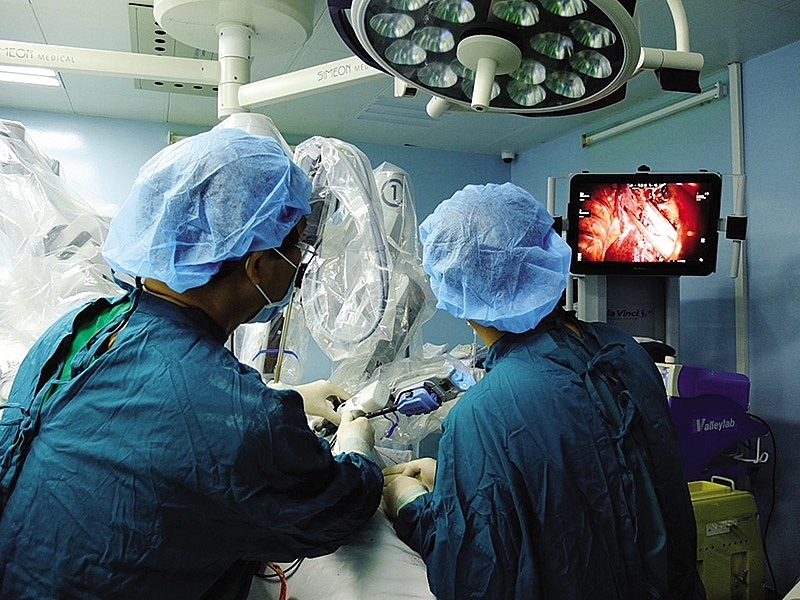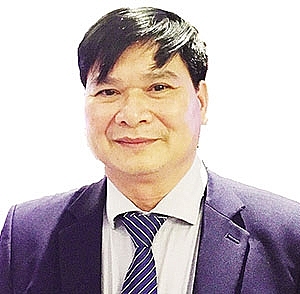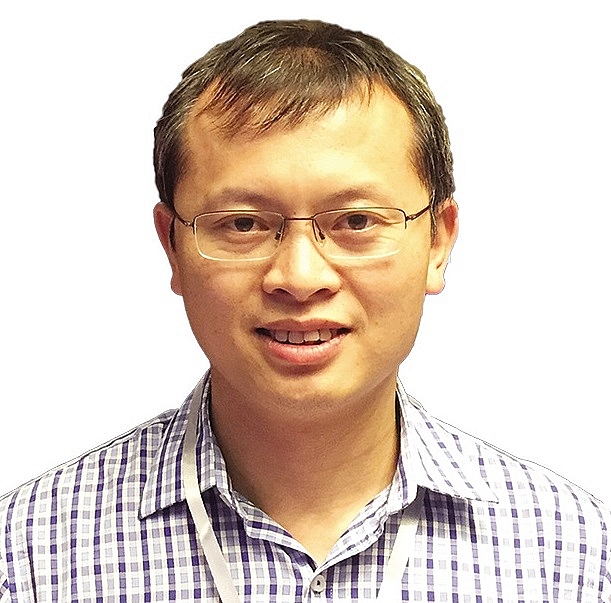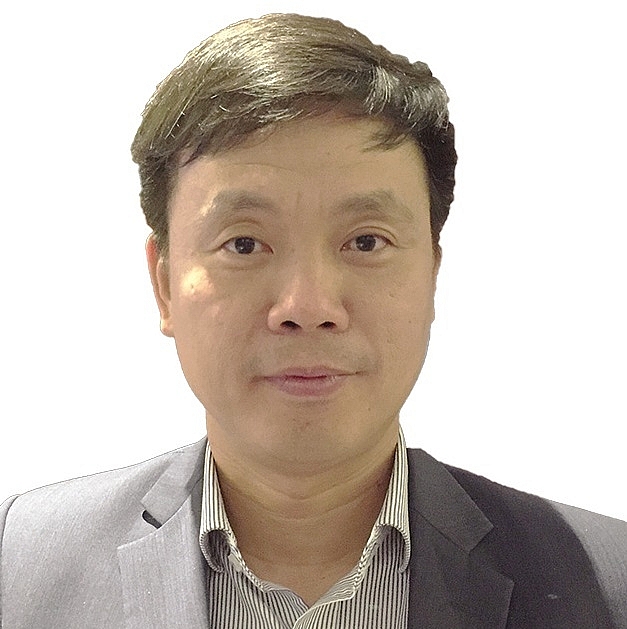Vietnam’s state-of-the-art robotics
 |
| Several hospitals in the country have recently performed nationwide first involving complicated surgery using robots, Photo: Le Toan |
At last week’s conference on Medical AI held by the Ministry of Health and Vietnam’s leading technology group FPT Software, experts agreed that AI is changing the entire world, including the medical sector.
“Gobally, the field involves the most AI applications. It is expected to transform the whole medical sector in the years to come. Vietnam is not an exception,” said Nguyen Tien Dung from the University of Toulouse in France.
Dung cited global market research and consulting firm MarketsandMarkets as saying that AI in the global medical sector rose by over 50 per cent annually, expecting to reach from $2.1 billion in 2018 to $36 billion in 2025, making up 20 per cent of the total AI market.
Not only helping to reduce examination and treatment costs by half and increasing quality by 40 per cent, AI application has become an inevitable trend in the Vietnamese medical market.
In mid-February, Ho Chi Minh City-based People’s Hospital 115 successfully performed robot-assisted brain tumour surgery, making it the first case of its kind in Asia. With the case, the hospital has made a hallmark in the medical field in both Vietnam and the wider region.
According to Prof. Amin Kassam, vice president of Aurora Health Care, the Modus V Synaptive robot system first used in the United States in 2015 was brought to the hospital last year. The system is designed to be used in neurological and skull surgeries.
Robotically-assisted brain surgery has been widely used in developed countries such as the US, Canada, and Australia, allowing doctors to perform complex procedures with more precision, flexibility, and control than conventional techniques. Robotic surgery is usually associated with short, minimally-invasive surgeries.
“The hospital now has around 400 inpatients. The number of patients getting neurosurgery is 2,350 cases a year on average. Thus, the investment in advanced technologies like robots is a top priority,” said Dr Phan Van Bau, director of the hospital.
Though People’s Hospital 115 made medical history, Binh Dan Hospital is actually the pioneer in the application of robots in surgeries. In 2016 the hospital used a robot known as the American DaVinci in its surgeries. The following year the hospital successfully used a robot in surgery for an elderly liver cancer patient. To date, the hospital has performed around robot-assisted surgeries for 585 patients.
Following this trend, many other hospitals have made huge investments to follow their lead. Each robot is said to cost around VND54-70 billion ($2.35-3.04 million. Ho Chi Minh City-based Cho Ray Hospital, Quang Ninh Obstetrics and Pediatrics Hospital, and the National Pediatrics Hospital are among the prominent names.
Late last year Quang Ninh Obstetrics used a robot arm for the first time in uterus surgery for a 49-year-old woman. Cho Ray Hospital also carried out two robot-assisted kidney transplant surgeries, also a first.
“With the price cheaper by up to seven times than robot surgeries in Singapore and the US, technology innovation has helped to curb the trend of Vietnamese people going abroad for advanced medical services, thus keeping around $3 billion a year from their overseas services,” industry insiders said.
At present, hospitals in the US are known to have 3,000 robots which assist surgeries, while the number in South Korea is 100, around 10 each in Thailand and Vietnam. Though the number is not significant, it is likely to increase strongly in the future as many more Vietnamese hospitals make plans.
| Pham Hoang Kham - Head of Department of Dermatology, 103 Military Hospital
The application of AI in the treatment of skin problems helps both doctors and patients as well as customers easily implement at any time. Patients or clients can use their mobile phones or any support tool to take pictures, then send them to doctors. Photos are put in the machine to be analysed, the machine then can diagnose and give recommendations for patients and customers. However, before that, doctors must train and teach the machine by giving it data of images, analysis, and diagnosis. In the process of learning, the machine also contains errors that need to be checked and adjusted by doctors so that the machine can gradually correct and improve itself. When the machine has a huge amount of knowledge, it can examine and diagnose by itself with high accuracy. For example, in China, there was a test to compare efficiency of an AI machine and 15 leading doctors in diagnosing cancer on 225 patients. The results showed that within 15 minutes, the machine gave the accurate diagnosis while the 15 doctors took twice as long. Cao Minh Duc - Software engineer 4Catalyzer (US)
Applying AI in health has scientific value so its achievements can be used widely. It brings very practical values for examinations and treatment. It is proven that AI allows us to diagnose earlier and more accurately. For example, in case of blood infection, the prescription of medicine is very important. It is calculated that if there is a delay of just one hour in administering the correct medicine, the mortality rate increases by 8 per cent. AI can help read DNA of the bacteria, then diagnose the bacteria and its resistance with up to 99 per cent accuracy. More importantly, with the application of AI, we can get the result of the bacteria in just six to eight hours instead of two days as before with traditional methods. AI is really a leap forward in health. Furthermore, AI effectively helps students and young doctors to enrich their knowledge and skills. Pham Minh Tuan - General director FPT Software
|
What the stars mean:
★ Poor ★ ★ Promising ★★★ Good ★★★★ Very good ★★★★★ Exceptional
 Tag:
Tag:
Themes: Healthcare
Related Contents
Latest News
More News
- Protect what’s next: towards a future free from meningococcal group B disease (December 05, 2025 | 18:00)
- New ILO report offers policy recommendations for disability inclusion (December 04, 2025 | 15:18)
- Maternal job loss may affect children’s mental health, research shows (December 03, 2025 | 19:11)
- Women lead Vietnam’s shift to climate-resilient agriculture (December 03, 2025 | 19:10)
- Experts highlight unpaid care work as key barrier to gender equality (December 03, 2025 | 15:15)
- Opportunities and inequalities for women workers in Vietnam's garment industry (December 03, 2025 | 09:00)
- Vietjet flights carry love to devastated central region (November 28, 2025 | 11:35)
- New initiative to boost the fight against domestic violence (November 26, 2025 | 10:00)
- South Korea funds IOM relief for Vietnam’s typhoon-affected communities (November 24, 2025 | 15:33)
- AI and human-centred values set to shape the future of HR in Vietnam (November 21, 2025 | 18:04)

























 Mobile Version
Mobile Version